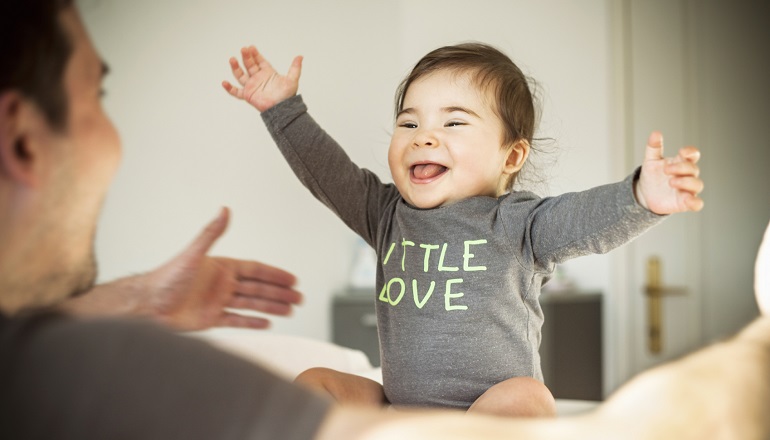Whether they join their families through adoption or childbirth, babies are, first and foremost, simply babies. And virtually all babies follow a basic path, passing through a predictable set of developmental and emotional milestones that all parents need to understand. Of course, our readers want to understand how babies adopted during the different stages of babyhood typically respond to the huge changes in their world. Keep in mind that each baby is unique and develops at her own pace. Nonetheless, the overview presented here can help you understand–and respond to–your baby’s behavior after adoption.
The first month of your baby’s life is all about meeting her physical needs: to be held, fed, and comforted to sleep. During this time, babies are relatively unaware that they are separate from their surroundings, and are just beginning to associate the care they get with the person who gives it. By month two, however, a baby begins to seek her mother’s presence, by smell and touch, in the same way that she seeks food, a dry diaper, or a nap. If your baby is newborn or under five months old at adoption, your most important task is to enhance bonding by keeping her close to you and responding consistently to her needs.
After working during the first five months to bond with her caretaker, a baby’s tasks over the next 17 months or so are, ironically, to begin to separate from the caretaker and to establish an independent identity. Here’s an overview of the developmental stages that follow and their implications for adoptive parents.
Developmental Stage: 5 to 10 months: The Individualist
The individualist’s social and motor skills have begun to develop, and he’s ready to interact with other people and explore his environment. Babies at this age become increasingly aware of themselves as separate and different from their mothers. A classic sign that this stage, known as “differentiation,” has begun is when a baby begins to prefer facing away from his parent when being held, so that he can see the world around him.
This is also a time when a baby sits up, crawls, explores his mother’s face with his hands, and stares with fascination at strangers around him, looking back to his mother for reassurance. A baby’s explorational interaction with the world around him is enhanced by the beginning of babbling.
By six or seven months, however, most babies develop stranger-anxiety—fear of unfamiliar people. Soon after, babies usually develop separation-anxiety—they may cry and cling when their mother leaves, and be withdrawn until she reappears. At this age, a baby can’t understand that, even though you go away, you’ll be back.
Adopting the Individualist…
Babies who’ve already developed separation anxiety by the time of their adoption may become intensely sad or fearful. A baby’s natural curiosity about the world may slow down. At the same time, his natural fear of strangers may be exacerbated. “After six months with his birth family, our seven-month-old became deeply depressed when he was placed with us,” says one mother. “He was inconsolable.” Sleep disturbances or night terrors are common for babies moved at this age.
Babies adopted from orphanages or institutions may arrive with “self-soothing” behaviors, like rocking or head-banging. “Seth came to us at five months,” says his mom, Gina Hagler. “He interacted well and smiled readily. But he never cried. When he wanted us, he either banged his head on the floor or screamed at the top of his lungs.”
…And Gaining His Trust
- Go back to basics. Even if a baby resists at first, try to hold her in a nursing position, perhaps even loosely swaddled. This may work best while giving a bottle before bedtime or a nap. The goal is to revisit and reinforce the eye contact and relaxation usually achieved during the nurturing of earlier months.
- Follow the care strategies of the previous caregiver. “We knew Lucy had been carried around by her foster mother for several months in the traditional Korean carrier,” says Anna Marie Bonafide. “So we tried to keep her close, taking her in a carrier when we went shopping or even while doing chores around the house.” Stay with her during self-soothing behaviors. “I decided that, if Seth wasn’t going to cuddle with us, I was going to hold him anyway and let him bang his head on me,” says Gina. By participating with your child, you’ll help him associate you with comfort.
- Maintain your baby’s routines. Now’s not the time to change feeding or nap times. Routines are reassuring.
- Keep it playful. Play pat-a-cake or peek-a-boo, sing a song, smile. The more your baby associates positive feelings with you, the stronger the developing relationship.
- Allow your baby to grieve. The cry of a grieving baby is painfully different from any other cry. However difficult you find it, stay with her, even if she won’t accept consolation. Try singing, walking, rubbing her back.
Developmental Stage: 9 to 18 months: The Explorer
The explorer is having a love affair with the world. Walking and then running, babies of this age discover toys, love to chase and be chased, and explore with fascination. At the same time, they check back visually and physically with their mothers for reassurance. Refueled with a hug or a smile, they are off again to continue their adventures.
When is professional help necessary?
If you are concerned about your baby’s physical or emotional development, see a developmental pediatrician or other knowledgeable therapist. Signs that you should seek guidance:
- Overly independent; lack of eye contact; overly compliant.
- Comprehension but no language development.
- Delayed crawling or walking.
- Sudden regression, after normal development.
- Unusual sensitivity to outside stimuli, like loud noises or “itchy” clothing.
- Difficulty sucking or chewing; unwillingness to feed self.
Babies at this stage begin to internalize the security they’ve absorbed from their mothers. The “transitional object”–a favorite blanket or a stuffed animal—provides a baby symbolic reassurance as he explores the larger world. Stranger anxiety is still a reality during this phase, usually peaking at about 12 months, then subsiding gradually by the time a child turns two.
Adopting the Explorer…
A baby adopted during the explorer stage of life needs to transfer the trust he’s developed with previous caretakers to his new family.
Age and mobility are not universal indicators for predicting an explorer baby’s adjustment to a new family. Instead, try to observe the baby with his pre-adoption caregivers. If he moves away to play and explore, then returns for reassurance, he is secure. If he moves away without ever checking back, however, he may have concluded that there’s no one to watch over him.
…And Gaining His Trust
- Revisit earlier stages of development. If your child missed early nurturing, rock him, hug him, give back rubs. Offer comfort, even if he doesn’t seek it. If your child missed “the individualist” stage, he may want to stay close to you while he explores the world around him visually before going on to explore physically.
- Teach your child to check in with you. To help your child know that you are the source of his safety, instill the checking-in behavior. Require that he check with you before playing with toys or leaving the room to play in another room. Make sure that you are there when the baby checks back in, and express joy in his accomplishments.
Developmental Stage: 15 to 22 months: The Diplomat
The diplomat alternates between courting her parents’ love, attention, and closeness, and trying their patience. Since her entry into toddlerhood, she wants to do more than she’s capable of and communicate beyond the limits of her language ability. For the first time since the child was born, parents have to set limits, reinforce positive behavior, and correct negative behavior. Although toddlers see themselves as separate individuals now, they don’t necessarily perceive other children or adults as human beings with feelings; hitting and kicking when stymied is the norm.
Increasing understanding of her own separateness leads a toddler to demand her mother’s attention, often by physically pulling at her to get it. A return of separation anxiety, shyness, or fear of strangers is also common in toddlers during this stage of development.
Adopting the Diplomat…
Toddlerhood is a particularly difficult stage for a child to be moved to a new home. He’s had time to build attachment to a caregiver, and now his greatest fear–losing that person–has come true. His cognitive and language abilities are not developed enough to explain adoption easily to him.
Children adopted at this age may cling to the new parent for fear of losing that person also. “Gena wanted to be in physical contact with me all the time,” says Gena’s mom, Susan Tombrello. “She would plaster herself to the shower door and whimper for me, or she would try to climb up on me just about anywhere I would sit. Cooking was very difficult when she outgrew her baby sling. I somehow learned to do everything with one hand.”
…And Gaining His Trust
- Prepare your child. Visit your child in the presence of the caregiver before placement. Together, talk to the child about the move before it occurs. It may help to act out the forthcoming adoption in play. If a pre-adoption visit isn’t possible, send your child an album of family photos or a recording of your voice so you’ll be familiar by your first meeting.
- Help your child identify feelings. Your child’s verbal abilities aren’t developed enough to express his feelings about the change in his life. Help him label emotions, such as fear, anger, and sadness.
- Record the circumstances. Write down as many details as possible about placement day. Take photos. As your child’s verbal skills develop, she will need to rework her emotions about that day. Details will help her understand what happened, why, and what it means.
- Get good advice. Children adopted as toddlers frequently struggle to balance dependence and autonomy. Professional advice can be helpful.
Adapted with permission from Real Parents, Real Children.



